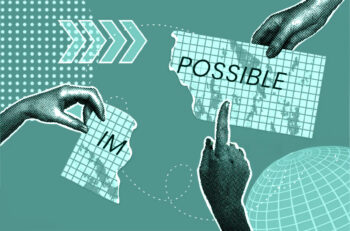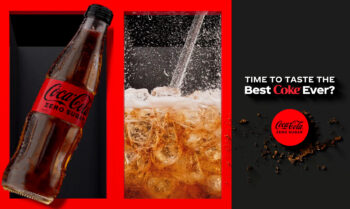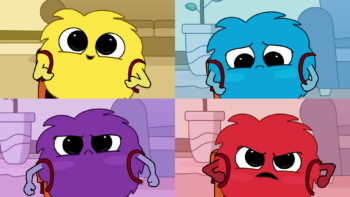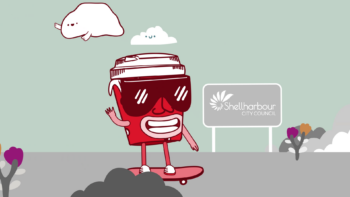
Have you ever seen an image that looks like a still photograph, but has one small part moving in a loop? That’s a cinemagraph!
A cinemagraph is like an animated photo. Part photo, and part video; it’s a mesmerising hybrid creation. This kind of content could be your chance to stand out in a sea of the same. So, if you’re looking for a way to add a little extra something to your marketing efforts, a cinemagraph could be the perfect solution.
In this article, we’ll explore the world of cinemagraphs and how they’re made. Plus, I’ll share some creative ways and pointers to use in your own marketing.
What is a cinemagraph?
A cinemagraph is a type of animated content that combines still imagery with a small, repeating movement. They’re like a cross between a photo and a video; with only one element within the photo that moves in a loop. They can be eye-catching and almost hypnotic in their repetition. We usually provide this type of content in GIF or video format, which means you can easily embed it into a blog post or social media content.
For example, you could create a cinemagraph of a coffee cup with steam rising from it, where the steam is the only thing moving in the image. Or you could make a cinemagraph of a person waving in a crowd, with only the person’s movement visible.
In simple terms, cinemagraphs are like living photos.
Bring unexpected life to your content
Whether you’re selling a service or a product, cinemagraphs are great ways to bring unexpected life to your content. From advertising to social media, cinemagraphs are popping up here and there. This is for good reason – they’re eye-catching, engaging, and a fun way to add a little something extra to your content.
How is a cinemagraph made?
The overview
To create a cinemagraph, we start with a video or series of photos that capture a scene with some kind of movement. Then, we use software to edit the footage and mask out the parts of the image that should remain still. This process leaves only a small element of the scene in motion. What you get is a still image that appears to have a subtle, repetitive movement.
Setting up the shot
Shooting a cinemagraph has its quirks. Deciding on the placement of action, ensuring elements loop and ensuring consistent lighting (and that’s to name a few). For the set dresser, the trick is to make sure that the elements that are going to stay still, stay still. This is often easier said than done. Check out our behind-the-scenes video on the creation of some test cinemagraphs:
Post-production
But, the bulk of the work happens in post-production. There, artists select the action moments, freeze everything outside of that, and animate the live plate in a seamless loop. These ‘finishing touches’ can take up about 70% of the workload.
Our cinemagraph process, from start to finish
Whether you sell a product or a service, I’m sure you could imagine some cinemagraph ideas.
1. Choose your product or service
Pick the product or service that you want to use in your cinemagraph. You want this to be something you could capture with a photograph, whether it’s a physical product or your team in action.
2. Pick a feature to highlight
Decide what key feature you want to spotlight. These features could be tangible (like a product feature), or intangible (like a feeling).
For a new type of shoe that’s due to launch, you might want to focus on the sleek design of the sole. For your car sales business, you might want to focus on the excitement your customers feel when they buy a new car.
3. Plan the shot
Once you’ve decided what you want to spotlight, now it’s time to decide what part of the ‘picture’ will move. This involves planning out a scene that you want to shoot. It could be anything from an outdoor picnic scene, to a product sitting atop a table.
Ask yourself:
- What emotions am I wanting to convey?
- What is in the scene? People? Other items?
- Where do I want the audience’s eyes to go first?
- How can I bring my brand into this scene?
4. Get the shot
If you have the equipment or an at-home studio, now’s your time to shine. Here are some tips:
- Choose the right location and setting: Think about the theme and mood you want to convey in your cinemagraph, and choose a setting that fits. Make sure the lighting is consistent and appropriate for the scene.
- Determine the focus of the movement: Decide what element or action you want to feature in your cinemagraph, and make sure it is clearly visible in the frame.
- Set up your camera and equipment: Use a tripod to ensure that the camera stays steady during the shoot. Consider using a continuous lighting source to avoid fluctuations in light.
- Practice patience: It may take several takes to get the perfect shot, so be prepared to experiment and try different angles and movements.
If you’d rather work with a creative studio, we’re here to help. Here’s a behind-the-scenes video we made of our process:
Where are cinemagraphs used?
You can find them in advertising, social media, and other visual media. Anywhere where a photo or video could be, you might stumble across a cinemagraph.
Cinemagraphs can be particularly effective on social media platforms, where they can stop users from scrolling and draw them to a branded message. In this announcement from Netflix, they are using a cinemagraph to announce the second season of Stranger Things. These hybrid visuals can be used in a variety of ways on social media platforms, such as in posts, stories, and ads. They’re like the best of both worlds (video and photo).
Source: Brooks Brothers via Adweek
In digital advertising
Cinemagraphs can be a powerful tool for advertising, as they offer a unique blend of static and moving elements that can grab the attention of viewers and leave a lasting impression. They can be used in a variety of advertising contexts, such as TV commercials, print ads, and digital banners.
New beats, new kicks, new tricks and a lemon-lime flavoured Sprite are your refreshment. #YourThirstComesFirst pic.twitter.com/Ed3VP7FTpB
— Sprite South Africa (@sprite_za) March 24, 2017
In product marketing
Cinemagraphs can be used to showcase a product or service in a creative and engaging way. For example, a fashion brand might use a cinemagraph of a model walking down the runway, with only their clothing and accessories in motion. This can give viewers a sense of the product’s movement and texture, and help them envision themselves wearing it. Cinemagraphs can also be used to highlight specific features or benefits of a product, like the sparkle of a drink or the texture of a cake.
Cinemagraphs are relatively easy to create and can be used in a variety of ad formats, such as posts, stories, and banners. This makes them a flexible and cost-effective option for social media advertising.
Some ideas for your first cinemagraph
- A product in use (a swinging handbag on a stationary woman)
- A lifestyle shot (steam curls up from the cups of a couple sitting down for breakfast)
- A feeling you want to bring to life (a vibrant, lively party, with champagne being poured from a bottle)
- An aesthetic product set up (a perfume bottle is surrounded by blossoming flowers)
- A landscape scene (waves crash on the shore, everything else is frozen in time)
- A surprise action (a photograph of a motionless man winks unexpectedly at the viewer)
- A satisfying loop (the pages of an open book turn endlessly)

More advice from our experts
Coming up with ideas for your cinemagraph is often the easy part. Bringing them to life is the tricky part! I asked our resident cinemagraph makers for some advice on how to make them.
Here are some pointers:
- Looping visuals are a great way to bring intrigue to otherwise mundane everyday experiences, a pouring wine bottle that never runs out places the viewer on the edge of their seat while they wait expecting it to empty.
- Think of something that will make looping it easy. Anything to do with liquid is a good example of this. Stirring or pouring water creates a motion that is repeatable.
- Start with what you want to feature and then build the set around it. Knowing where the focus will be from the start will ensure you only build what is complimentary around your key message.
- The motion should often be in contrast to the stillness of the rest of the frame, allowing things in motion to be frozen around your moving element can really emphasise and draw attention to your subject. Think of how much a single person clapping in a crowd stands out compared to when the whole crowd claps.
- For consistency, during the shoot make sure the lighting is controlled and your set is taped down. Even the slightest changes can break the looping illusion.
Interested in making a cinemagraph?
In the saturated market of both static and moving content, the cinemagraph’s unique blend of the two can stand out amongst competitors. The looping imagery can mesmerise your audience, keeping their attention as they try to find where the action starts and finishes. And once you have your audience’s attention, you can direct them to the website, product or offering you are promoting.
Are you looking to bring your vision to life with the help of a professional crew? Look no further! We would be thrilled to work with you on creating cinemagraphs for your business. Let’s chat about how we can make this happen. We can’t wait to hear from you!




